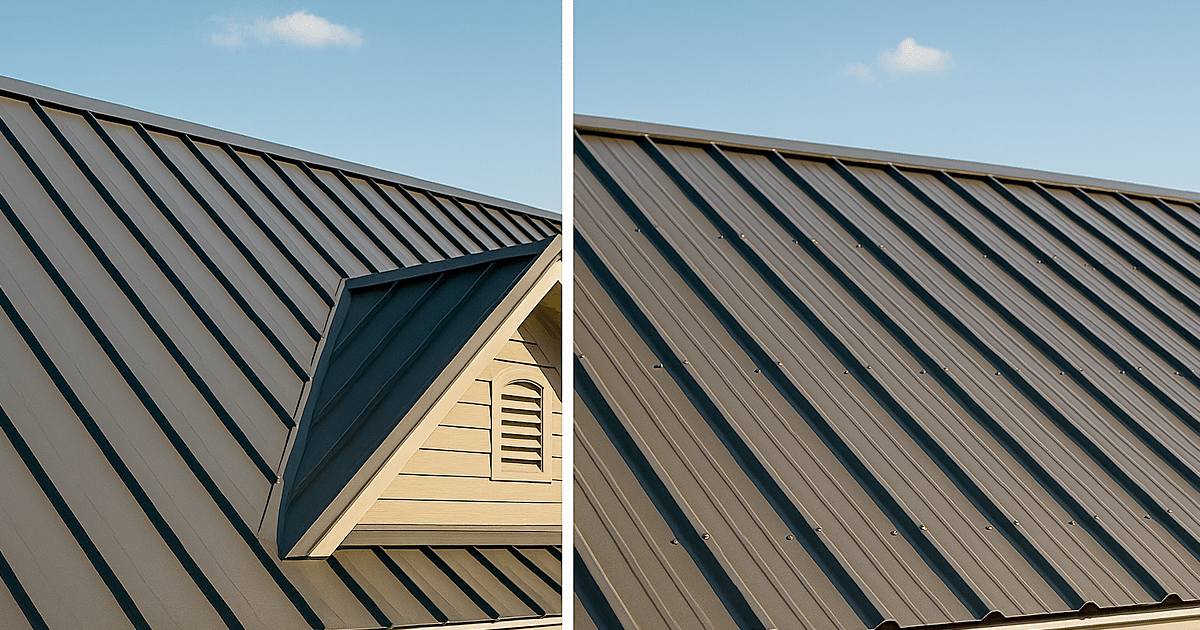When choosing metal roofing, the fastener system determines everything from weather resistance to long-term costs. Both standing seam metal roofs and exposed fastener metal roofs use similar core materials; in fact, both systems use the same materials, but their construction and benefits vary significantly, leading to differences in performance, installation, and lifespan. So, standing seam metal roof vs exposed fastener metal roof: which is right for your project?
The fundamental distinction lies in how metal panels attach to your roof structure. Standing seam metal roofing features concealed fasteners hidden beneath raised seams, while exposed fastener metal roofing relies on visible screws that penetrate directly through the metal panel and into the roof deck.
This comprehensive guide examines the critical differences between these roofing systems, helping you determine which metal roofing option best fits your project requirements, budget constraints, and long-term goals.
Choose the Right Metal Roofing System for Your Needs
Standing seam metal roofing delivers premium durability through its concealed fastener design, offering superior weather protection and minimal maintenance requirements. The raised seams create an uninterrupted barrier against water infiltration while allowing thermal expansion without compromising the roof’s integrity. Standing seam roofs also provide a modern aesthetic with a variety of panel styles, allowing for more customization to suit different architectural preferences.
Exposed fastener metal roofing provides a budget-friendly installation option with visible screws securing overlapping metal panels directly to the substrate. This straightforward approach reduces initial costs and installation complexity, making it accessible for DIY projects and cost-sensitive applications.
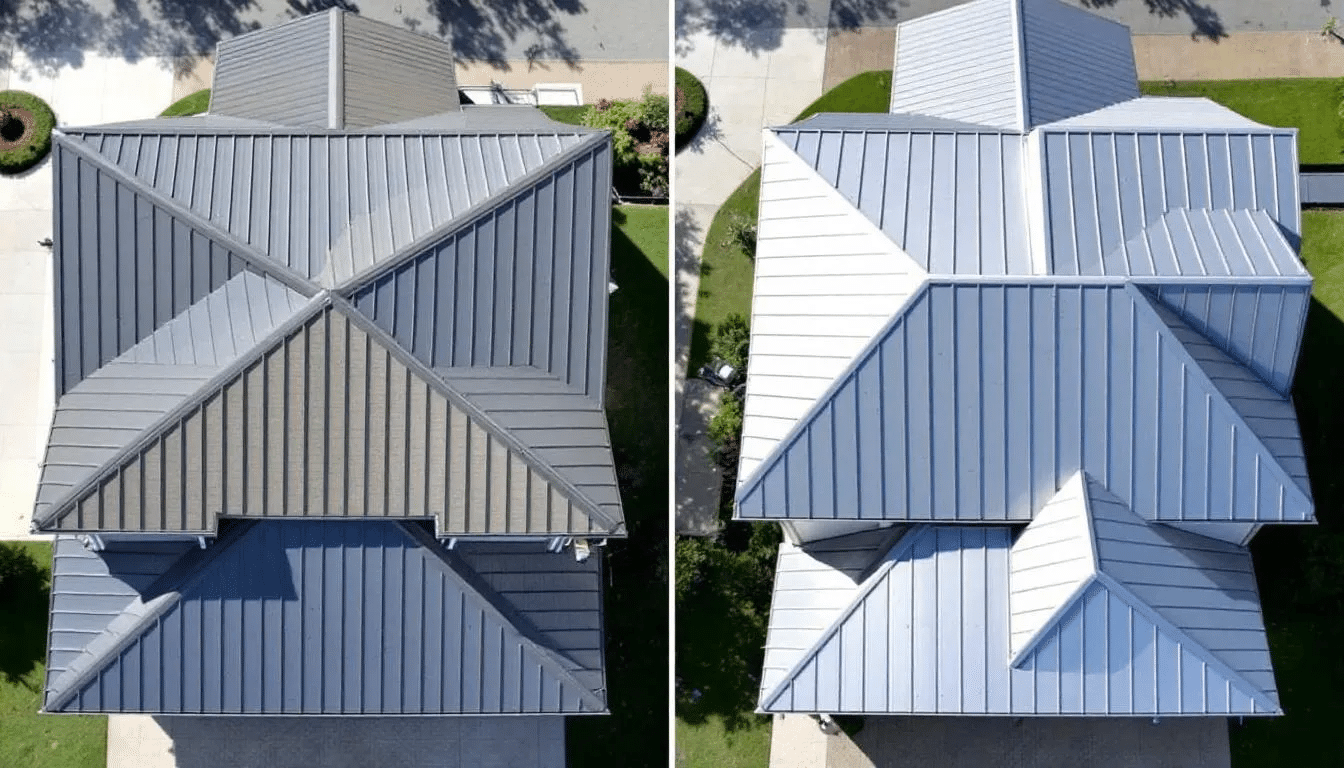
Both systems utilize similar materials—typically galvanized or Galvalume steel, aluminum, or copper—but differ significantly in panel gauge, installation complexity, and long-term performance expectations. The choice between concealed and exposed fasteners impacts everything from weather resistance to maintenance schedules.
Understanding these distinctions helps property owners, contractors, and architects make informed decisions based on the unique requirements of your roofing project, including specific project requirements, climate considerations, and budget parameters.
What Makes These Metal Roofing Systems Unique?
Standing Seam Metal Roofing – Premium Performance Excellence
Standing seam metal roofing consists of vertical metal panels with raised seams running continuously from ridge to eave. These seams stand approximately 1 to 2 inches above the panel surface, creating the system’s distinctive linear appearance while concealing all fastening hardware beneath.
The concealed fastener system uses specialized clips or brackets that secure panels to the roof structure without penetrating the exposed metal surface. This design eliminates hundreds of potential water entry points while allowing panels to expand and contract up to half an inch with temperature changes. However, improper installation by an unqualified contractor can lead to performance issues and may void manufacturer warranties, so it is crucial to hire a certified roofing contractor for standing seam systems.
A standing seam panel is especially suitable for very low sloped roofing due to its concealed fasteners, which help prevent water leakage. Standing seam panels typically utilize 22-24 gauge steel, aluminum, or copper with premium PVDF paint systems that resist fading and weathering. The thicker metal gauge provides enhanced durability and wind resistance compared to thinner alternatives.
Key applications include residential homes seeking modern aesthetics, commercial buildings requiring long-term performance, and architectural projects where clean lines and weather-tightness are priorities. The system’s compatibility with solar panel mounting and snow retention accessories makes it ideal for complex roofing installations. When considering installation and performance, selecting a roofing contractor with experience in standing seam metal roofing is essential to ensure proper installation and maintain warranty coverage.
Exposed Fastener Metal Roofing – Practical Cost-Effective Solution
Exposed fastener metal roofing features overlapping panels secured with visible screws that penetrate through the metal and into the roof deck. These exposed fastener options are a category of metal roof panels with visible fasteners, in contrast to hidden fastener systems like standing seam roofs. This design is known as an exposed fastener system, characterized by its visible fasteners and straightforward installation. These fasteners, typically spaced 12 to 24 inches apart, include neoprene washers to provide basic water protection around each penetration point.
Exposed fastener roofing systems create many roof penetrations, which increases the risk of water leaks and maintenance needs compared to concealed fastener systems. The direct attachment method simplifies installation significantly, requiring only standard tools and basic roofing knowledge. Panel profiles include corrugated, PBR (Purlin Bearing Rib), and various ribbed designs that shed water through their geometry and overlap configuration. Exposed fastener roofs often use wider panels to reduce material and installation costs, making them a more economical choice.
Most exposed fastener panels use 24-29 gauge steel, with 26-29 gauge being most common to balance cost and performance. The thinner metal reduces material costs while maintaining adequate strength for most applications.
Primary applications include agricultural buildings, warehouses, residential outbuildings, and DIY projects where budget constraints outweigh long-term performance considerations. The system’s wide availability at home improvement stores makes it accessible for immediate purchase and installation.
Maintenance for exposed fastener systems requires frequent maintenance due to issues like loose screws, gasket deterioration, and potential water penetration. Regular fastener upkeep is essential to maintain roof integrity and prevent leaks. During maintenance, it is important to inspect foam closures to ensure proper sealing around fasteners and prevent water intrusion.
Standing Seam vs Exposed Fastener: Performance Comparison
Weather Resistance and Durability
Standing seam metal roofing provides superior weather-tightness through its concealed fastener design, eliminating the hundreds of penetration points that create potential leak sources in exposed fastener systems. The continuous raised seams effectively channel water and snow away from the roof surface, even on lower-pitched installations. When performing maintenance, it is important to inspect for cracked sealant around fasteners, as this is a common issue that can lead to water intrusion if not addressed.
Manufacturers typically offer weathertight warranties of 20-35 years for standing seam installations, reflecting confidence in the system’s water resistance. Expected lifespans range from 50-70 years with proper installation and minimal maintenance requirements. A standing seam metal roof requires less maintenance than exposed fastener systems due to its concealed fastener design, reducing the risk of leaks and deterioration.
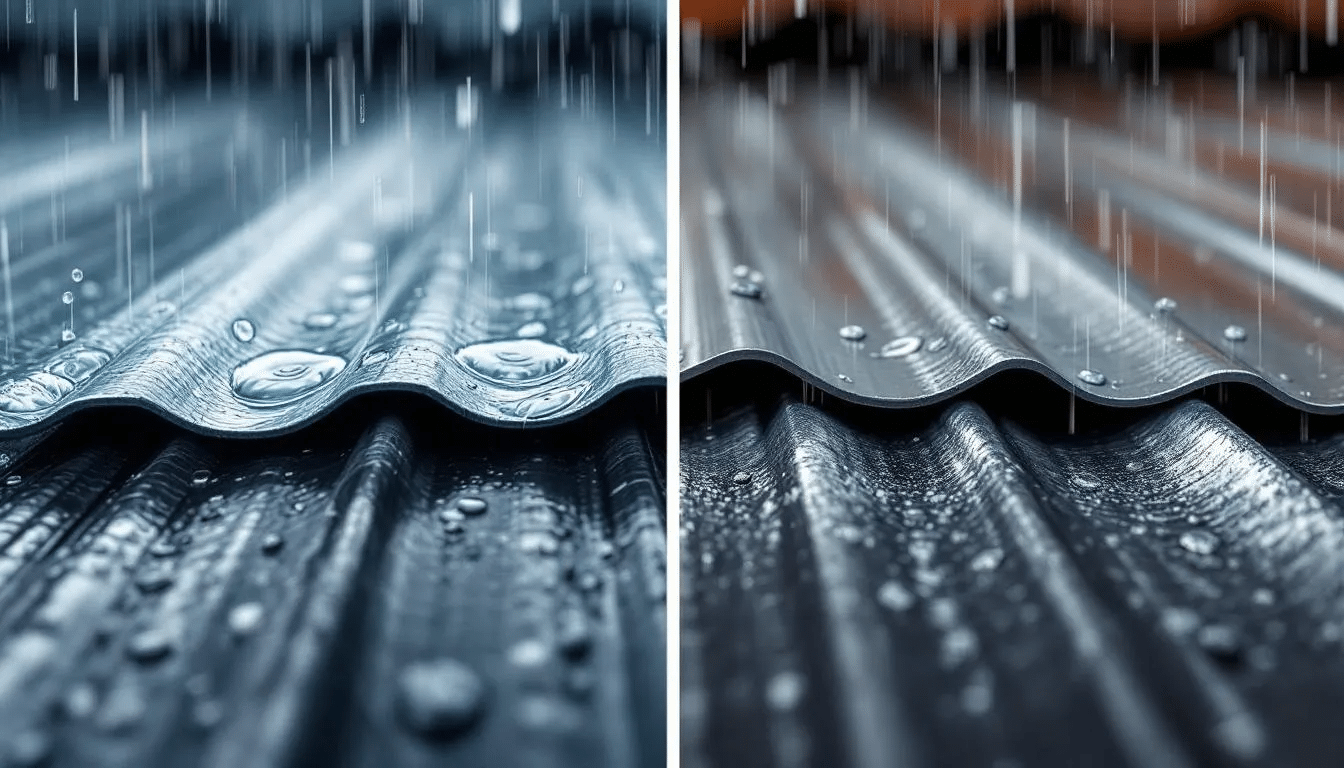
Exposed fastener metal roofs face inherent challenges from their direct penetration attachment method. Each roof may contain 60 to over 100 fasteners per 100 square feet, creating multiple points where water infiltration can occur as washers degrade or fasteners loosen over time. Different types of metal roof panels are used in each system, such as standing seam panels for concealed fastener systems and exposed fastener panels for traditional installations. Neglected maintenance or improper installation can result in costly repairs due to leaks or structural damage.
| Performance Factor | Standing Seam | Exposed Fastener |
|---|---|---|
| Weather-tight warranty | 20-35 years | Paint only (no water tightness) |
| Expected lifespan | 50-70 years | 20-40 years |
| Wind uplift rating | Up to 140 mph | 90-120 mph |
| Minimum roof slope | 0.5/12 (mechanical seam) | 3/12 |
| Leak resistance | Excellent | Moderate (requires maintenance) |
Wind uplift performance favors standing seam systems due to their engineered panel engagement and continuous clip attachment. Properly installed standing seam roofs can resist winds up to 140 mph, while exposed fastener roofs typically handle 90-120 mph depending on fastener spacing and panel design.
Installation and Maintenance Requirements
Standing seam metal roof installation demands specialized skills, tools, and experience to achieve proper panel alignment and watertight seam connections. Mechanical seam systems require portable seamers to fold and lock panels on-site, while snap-lock systems need precise clip placement and panel engagement. Hidden fasteners are a key feature of standing seam systems, enhancing durability and weather resistance by eliminating visible fasteners and minimizing potential leak points.
The complex installation process typically requires 20-40% more labor time than exposed fastener systems, contributing to higher initial costs. However, fewer qualified contractors are available—industry estimates suggest less than 20% of general roofers offer advanced standing seam installation services.
Maintenance requirements for standing seam roofs are minimal, typically involving annual or biennial inspections for seam integrity and basic cleaning. The concealed fastener design eliminates the need for regular fastener monitoring and replacement.
Exposed fastener metal roofing offers straightforward installation using standard tools and conventional roofing techniques. Most general contractors and skilled DIYers can complete installations with basic power tools and proper safety equipment.
Installation speed advantages are significant—exposed fastener roofs can be installed twice as fast as standing seam systems due to simpler attachment methods and wider contractor availability. Materials are readily available at home improvement retailers for immediate purchase.
However, exposed fastener roofs require ongoing maintenance to address fastener degradation and washer replacement. Typical maintenance cycles occur every 7-15 years, depending on climate exposure and UV intensity. Neglected fastener maintenance can lead to water intrusion and costly substrate damage.
Cost Analysis
Standing seam metal roofing costs range from $8-14 per square foot installed, with $10-12 representing typical residential project pricing in 2024. The higher investment reflects premium materials, specialized labor, and complex installation requirements. Standing seam systems have a higher upfront cost compared to exposed fastener options, but this initial expense is often justified by their enhanced durability and weather resistance.
Material costs for standing seam panels average 40-60% higher than exposed fastener alternatives due to thicker metal gauges and precision manufacturing tolerances. Labor costs increase substantially due to specialized skills and extended installation time requirements.
Exposed fastener metal roofing averages $4.50-5.50 per square foot installed, representing 50-60% savings compared to standing seam systems. The cost advantage stems from thinner gauge metal, simplified installation, and widespread contractor availability.
When evaluating long-term costs, standing seam systems often achieve cost parity after 20-25 years when factoring in maintenance savings and extended lifespan. The initial premium investment is offset by reduced repair frequency, minimal maintenance requirements, and superior durability. The durability of metal roofs can also reduce the frequency and overall cost of roof replacement over time, making them a cost-effective choice in the long run.
Additional cost considerations include:
- Standing seam advantages: Minimal maintenance, longer warranties, better resale value, energy efficiency benefits
- Exposed fastener advantages: Lower insurance requirements, DIY installation possibility, immediate availability, simpler repairs
Energy Efficiency and Sustainability
When evaluating metal roofing options, energy efficiency and sustainability are increasingly important factors for both residential and commercial projects. Standing seam metal roofs stand out for their superior energy efficiency, thanks to their ability to reflect a significant portion of the sun’s rays. This is largely due to advanced reflective coatings and high-quality paint systems applied to the metal panels, such as PVDF finishes on painted aluminum or Galvalume steel. These coatings help reduce heat absorption, keeping buildings cooler in the summer and lowering air conditioning costs—a major advantage for energy-conscious property owners.
Standing seam metal roofs also contribute to sustainability through their long lifespan and recyclability. Most standing seam roofs are made from materials that can be fully recycled at the end of their service life, minimizing environmental impact and supporting green building initiatives. The durability of seam metal roofs means fewer roof replacements over time, further reducing waste.
Exposed fastener metal roofs can also offer energy efficiency benefits, especially when manufactured with reflective coatings and installed with proper ventilation. However, their performance may vary depending on the quality of the paint system and the gauge of the metal used. Lower quality paint systems on exposed fastener metal roofs may not reflect solar energy as effectively, potentially leading to higher cooling costs. Despite this, both exposed fastener and standing seam metal roofs are considered sustainable choices due to their durability, recyclability, and ability to reduce the need for frequent roof replacements.
Ultimately, whether you choose standing seam or exposed fastener metal, selecting metal panels with high-quality, energy-efficient coatings and ensuring proper installation will maximize the energy savings and sustainability benefits of your new roof.
Compatibility with Other Roofing and Building Systems
Compatibility with other roofing and building systems is a key consideration when selecting between standing seam metal roofs and exposed fastener metal roofs. Standing seam metal roofs are especially valued for their seamless integration with solar panels and other rooftop accessories. The raised seams of standing seam panels allow for solar panel mounting systems to be attached using specialized clamps, eliminating the need for penetrating holes in the roof. This not only preserves the weather-tight integrity of the standing seam roof but also simplifies the installation of solar panels, snow retention systems, and other rooftop equipment.
In contrast, exposed fastener metal roofs require a more careful approach when integrating additional systems. Because exposed fastener roofs rely on visible screws that penetrate the metal panels, adding solar panels or other rooftop features often involves creating more roof penetrations. This can increase the risk of leaks if not properly sealed and flashed. For exposed fastener metal roofs, it’s essential to use high-quality flashing and sealants around any new penetrations, and to ensure that all fastener heads are properly installed and maintained to prevent water intrusion.
Both standing seam and exposed fastener metal roofs can be compatible with a range of building systems, including metal shingles and fastener panels, provided they are properly installed and maintained. The key is to work with experienced roofing professionals who understand the unique requirements of each system and can ensure that all components—whether solar panels, skylights, or snow guards—are integrated without compromising the performance of the metal roof.
By considering the compatibility of your chosen roofing system, you can ensure a roofing solution that not only meets your immediate needs but also supports long-term building performance and flexibility.
What Roofing Professionals Recommend
Industry experts consistently recommend standing seam metal roofing for projects prioritizing long-term performance, weather protection, and architectural appeal. The concealed fastener system addresses the fundamental weakness of exposed penetrations while providing thermal movement accommodation that prevents fastener fatigue.
Professional roofing contractors emphasize standing seam’s suitability for residential and commercial buildings where interior protection is critical. The system’s ability to handle low-slope applications—mechanically seamed panels work on pitches as low as 0.5/12—expands design possibilities for contemporary architecture.
Exposed fastener advocates highlight the system’s practical benefits for agricultural structures, utility buildings, and cost-sensitive projects. The simplified installation process and widespread contractor availability make it viable for remote locations or time-sensitive construction schedules.
A warehouse owner in Kansas replaced aging asphalt shingles with standing seam metal for improved leak resistance under snow loads. After 20 years, routine inspections revealed zero required maintenance beyond cleaning, validating the system’s durability claims.
Conversely, a Texas horse barn utilized exposed fastener panels to reduce material and labor costs by 55% compared to standing seam alternatives. The owner incorporated planned fastener replacement maintenance into the facility’s 10 and 20-year budget cycles.
Roofing professionals note that proper installation quality matters more than system selection for optimal performance. Improper installation by an unqualified roofing contractor can lead to performance issues and void manufacturer warranties, especially with complex systems like standing seam metal roofs. Poor installation can negate the advantages of either standing seam or exposed fastener systems, emphasizing the importance of qualified contractor selection.
Key Factors to Consider Before Choosing
Roof Slope and Building Requirements
Roof slope requirements differ significantly between standing seam and exposed fastener systems. Standing seam roofs accommodate low or steep pitches, with mechanically seamed panels working at 0.5/12 slopes and above, while snap-lock systems require minimum 3/12 pitches.
Exposed fastener roofs require minimum 3/12 slopes to ensure proper water shedding and prevent ponding at fastener locations. Flatter slopes increase leak risk at penetration points, making these systems unsuitable for low-slope applications.
Building code compliance varies by region, with some jurisdictions requiring specific wind ratings or fire classifications that favor standing seam systems. Insurance companies may offer premium discounts for metal roofing, with greater savings typically available for standing seam installations due to superior weather resistance.
Structural considerations include load requirements, expansion joint accommodation, and compatibility with rooftop equipment. Standing seam systems handle complex penetrations and accessory mounting more effectively due to their engineered clip systems and panel strength.
Contractor Availability and Installation Complexity
Standing seam installation requires specialized contractors with manufacturer certification and experience in proper seaming techniques. Homeowners should verify contractor qualifications, including insurance coverage, warranty backing, and references for similar projects.
Questions to ask standing seam contractors include:
- Manufacturer certification status and training completion
- Experience with specific panel types (mechanical seam vs. snap-lock)
- Insurance coverage for installation errors and warranty claims
- References from recent residential or commercial projects
Exposed fastener installation offers broader contractor availability, with most general roofers capable of proper installation. However, experience with correct fastener installation remains important to prevent early failures and warranty voids.
Certification requirements are less stringent for exposed fastener systems, but contractors should demonstrate knowledge of proper fastener spacing, washer selection, and slope requirements for optimal performance.
Aesthetic Goals and Architectural Style
Standing seam metal roofing provides clean, contemporary lines that complement modern residential and commercial architecture. Its sleek appearance not only enhances curb appeal but also offers exceptional architectural versatility, making it ideal for high-end and complex designs. The uninterrupted vertical seams create a sophisticated appearance that enhances property values.
Color and finish options are extensive for standing seam systems, with PVDF paint systems offering superior fade resistance and 40-year warranties. Custom colors and specialty finishes are readily available for architectural applications requiring specific aesthetic matches.
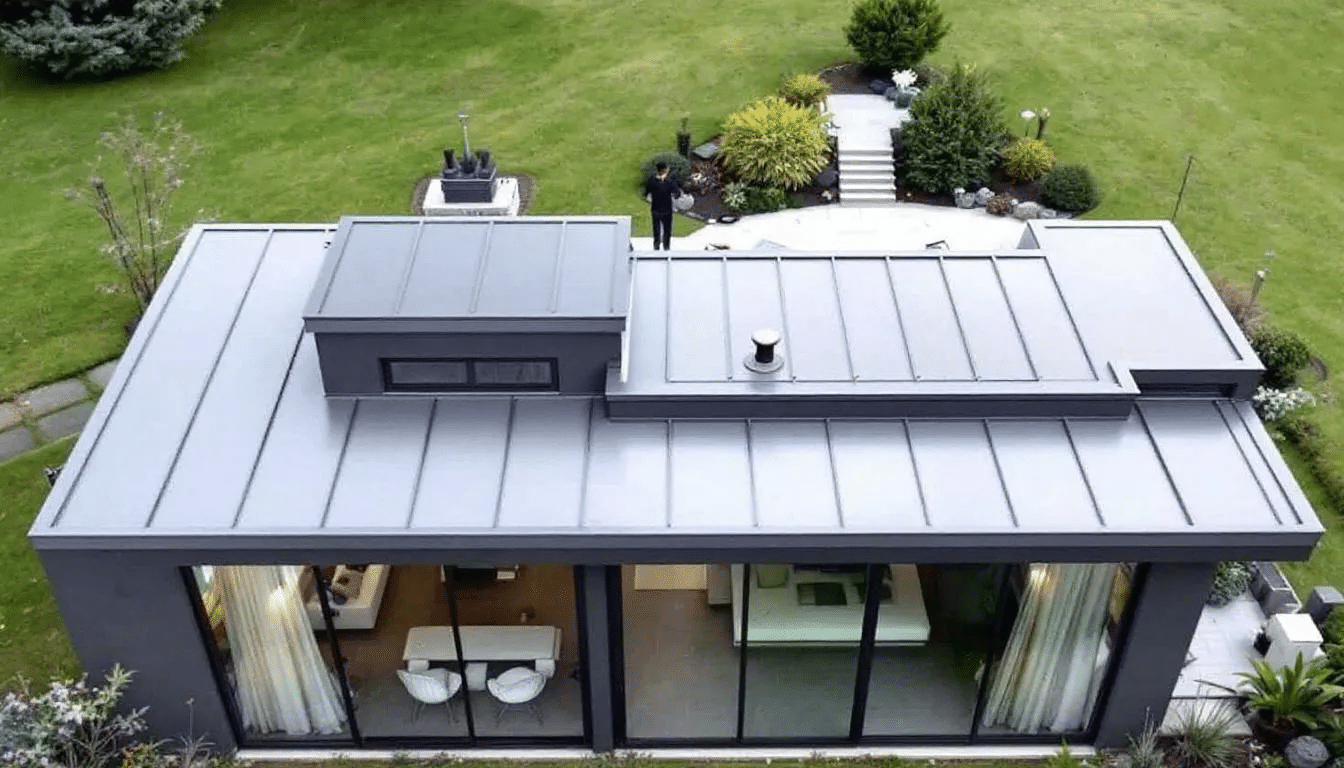
Exposed fastener roofing presents a more traditional or industrial appearance associated with agricultural and utility structures. The visible fastener pattern creates a functional aesthetic that suits rural settings and utilitarian buildings.
Finish options for exposed fastener panels may be more limited, with basic color selections and shorter warranty periods typical for lower-grade paint systems. However, recent improvements in coating technology have expanded options for projects requiring specific appearances.
Which Metal Roofing System Should You Choose?
Choose Standing Seam Metal Roofing If You Want:
Premium durability becomes your priority when selecting standing seam metal roofing systems. Standing seam roofing systems are recognized as a high-performance, durable, and energy-efficient solution, making them an excellent choice for property owners. The 50-70 year lifespan, combined with comprehensive weathertight warranties, provides long-term value that justifies the higher upfront investment for property owners planning extended occupancy.
Sleek modern appearance with concealed fasteners enhances architectural appeal and property values. The clean lines and uninterrupted panel surfaces complement contemporary design trends while providing flexibility for future modifications or accessory additions.
Minimal maintenance requirements reduce long-term ownership costs despite higher initial expenses. The concealed fastener design eliminates routine fastener inspections and replacements, making standing seam ideal for owners preferring hands-off roofing solutions.
Superior weather resistance protects interior spaces and structural components from water damage. The system’s ability to handle extreme weather events and thermal movement without compromising integrity makes it suitable for harsh climate applications.
Solar panel compatibility and rooftop accessory integration support future building improvements without roof modifications. The engineered clip systems accommodate mounting hardware without penetrating the weather barrier, preserving long-term performance.
Choose Exposed Fastener Metal Roofing If You Want:
Budget-friendly installation costs 50% less than standing seam alternatives, making metal roofing accessible for cost-sensitive projects. An exposed fastener roof is a straightforward and affordable option for many property owners, offering immediate savings that enable property improvements that might otherwise be delayed due to budget constraints.
Simple installation process with widely available contractors reduces project complexity and scheduling challenges. The straightforward attachment method of an exposed fastener roof allows faster completion timelines, important for time-sensitive construction or weather-dependent installations.
DIY-friendly projects become possible with materials available at home improvement stores and installation techniques within reach of skilled homeowners. The basic tool requirements and forgiving installation process of exposed fastener roofs support cost savings through owner participation.
Traditional appearance suits agricultural or utility buildings where functional aesthetics align with building purposes. The visible fastener pattern provides authentic industrial character for barns, workshops, and storage structures.
Quick installation timelines accommodate urgent roof replacements or seasonal construction windows. The simplified process enables faster weather protection when immediate solutions are required.
Making Your Final Decision
Budget analysis should compare upfront costs against long-term maintenance and replacement expenses over your planned ownership period. Standing seam systems typically achieve cost parity with exposed fastener alternatives after 20-25 years when factoring in maintenance savings and extended lifespan.
Performance priorities guide system selection based on weather resistance requirements, aesthetic preferences, and maintenance tolerance. Properties in harsh climates or requiring maximum weather protection favor standing seam systems, while cost-sensitive applications may prioritize exposed fastener affordability.
Building type and intended use considerations influence system appropriateness. Residential homes, commercial buildings, and architectural projects typically benefit from standing seam performance, while agricultural structures, utility buildings, and temporary facilities may find exposed fastener systems adequate. Fastener roofing systems have unique features, such as visible fasteners, which can lead to increased maintenance needs and potential water penetration issues, but they offer lower upfront costs and simpler installation compared to standing seam systems.
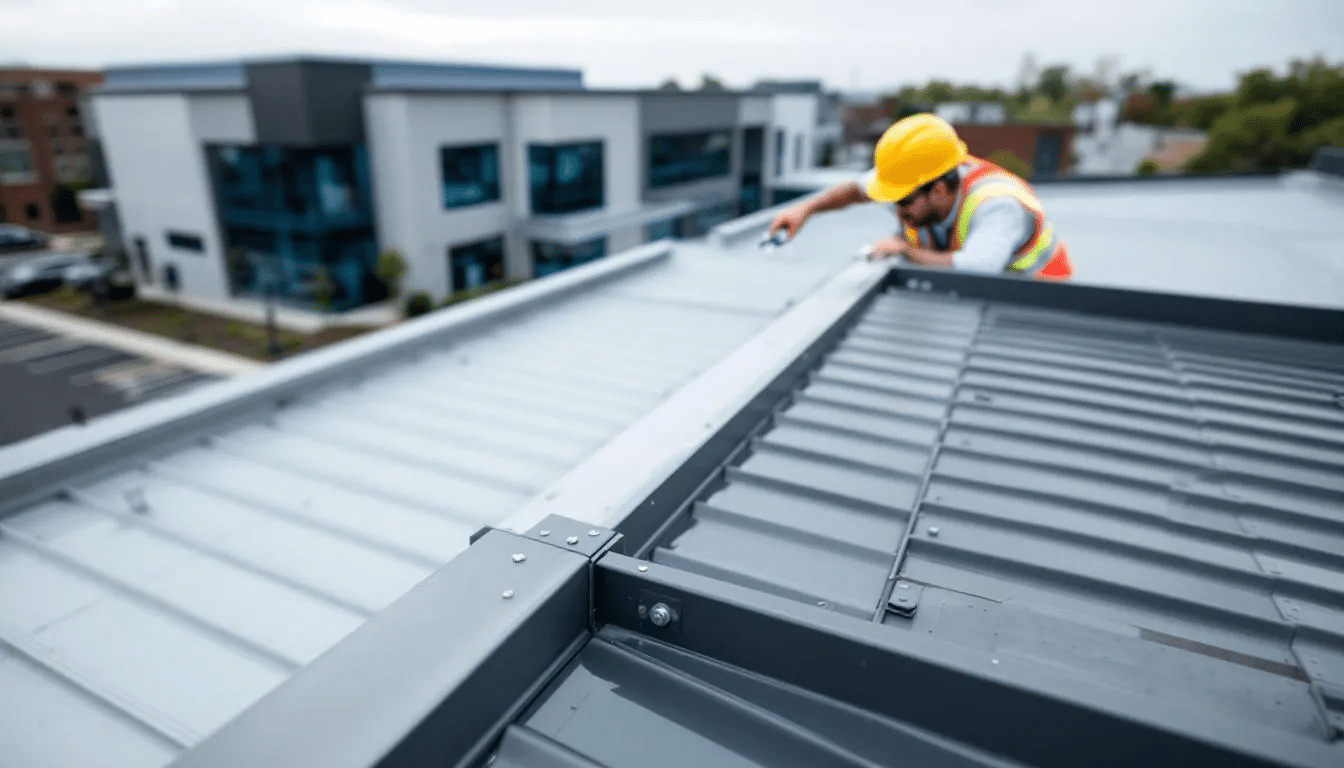
Consulting with qualified metal roofing professionals provides project-specific guidance based on local climate conditions, building codes, and performance requirements. For expert advice on both standing seam and exposed fastener systems, manufacturers like Western States Metal Roofing offer extensive experience and can help identify the best solution for your needs. Professional assessment helps identify potential challenges and optimal solutions for your specific application.
Proper installation quality remains critical regardless of system selection. Both standing seam and exposed fastener metal roofs require skilled installation to achieve optimal performance, emphasizing the importance of contractor qualification and experience verification.
The choice between standing seam metal roof and exposed fastener metal roof ultimately depends on balancing performance requirements, aesthetic goals, and budget constraints within your specific project context. Understanding these fundamental differences enables informed decisions that optimize long-term satisfaction and value.
Contents
- Choose the Right Metal Roofing System for Your Needs
- What Makes These Metal Roofing Systems Unique?
- Standing Seam vs Exposed Fastener: Performance Comparison
- Energy Efficiency and Sustainability
- Compatibility with Other Roofing and Building Systems
- What Roofing Professionals Recommend
- Key Factors to Consider Before Choosing
- Which Metal Roofing System Should You Choose?
- Making Your Final Decision

